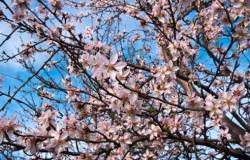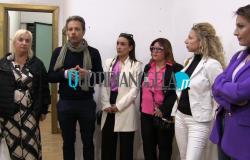Over the past weekend, the first edition of the Savona Book Fair took place in Savona, entitled “Readings among the cedars”; the cultural event, organized by Espansione Eventi di Paola Savella, in collaboration with the ASD Delfi Arte e Sport and the Villa Cambiaso Museum Association and the patronage of the City of Savona.
by Ezio Marinoni

The event in the splendid setting of Villa Cambiaso, in Via Torino, 10, from Friday 22nd to Sunday 24th March. There were many presentations, alternating between the courtly “Sala Rossa” and the modern “Sala Dune”.
Among the many meetings, the historian Franco Rebagliati presented his on Saturday the 23rd Stories from Savona between the 19th and 19th centuries900; the presentation of the guide was held on the morning of Sunday 24 March Quiliano: a city to discover. Between history, nature, culture, typical and… gastronomic products (Alzani Publisher); to illustrate the work, the Mayor Nicola Isetta and the Deputy – Mayor and Councilor for Culture Nadia Ottonello. Some Ligurian authors presented themselves to the Savonese public (Maria Masella, Fiorenza Pistocchi, Giuliana Balzano, Roberto Centazzo), in a succession of events and cultural moments that ranged across many narrative and non-fiction sectors, for adults and children.
Between stands of Ligurian, Lombard and Piedmontese publishing houses and meetings with authors, culture has therefore returned at the right pace within Villa Cambiaso, which in the past has seen the flourishing of the literary and artistic magazine of the same name, thanks to its illustrious and passionate host, the late Pio Vintera.
We have already dealt with his artistic “return” to the city of Savona in issue 31 of 24 March 2024: https://trucioli.it/2024/03/14/savona-e-pio-vintera-ritrattosta-vero-e- unpublished-self-taught-who-attended-fotograzia-many-of-his-works-are-snapshots-that-become-painting-the-neo-association-mu-vi-ca/
 Furthermore, on Sunday 24 March, the FAI (Italian Environment Fund) opened the Villa to the public, with guided tours accessible to all. The visit itinerary included: the fountain room (a spacious atrium with a marble fountain in the center attributed to Bernini, decorated with a central sculpture with dolphins); in succession, the anti-sacristy, the sacristy and the private chapel where there is a collection of rare miniature processional chests once used by the children of the house. The climb to the main floor, via the staircase adorned with grotesques to reach the once open loggia, allowed you to admire the stained glass windows of Florentine manufacture. We visited the blue room, the green room and the room of the zodiac signs. The games room amazed visitors with the presence of riddles carved into the wood of the boiserie. Lastly, the dining room, with the very particular ceiling fresco portraying Benito Mussolini with the plow in a wheat field.
Furthermore, on Sunday 24 March, the FAI (Italian Environment Fund) opened the Villa to the public, with guided tours accessible to all. The visit itinerary included: the fountain room (a spacious atrium with a marble fountain in the center attributed to Bernini, decorated with a central sculpture with dolphins); in succession, the anti-sacristy, the sacristy and the private chapel where there is a collection of rare miniature processional chests once used by the children of the house. The climb to the main floor, via the staircase adorned with grotesques to reach the once open loggia, allowed you to admire the stained glass windows of Florentine manufacture. We visited the blue room, the green room and the room of the zodiac signs. The games room amazed visitors with the presence of riddles carved into the wood of the boiserie. Lastly, the dining room, with the very particular ceiling fresco portraying Benito Mussolini with the plow in a wheat field.
In 2022 Villa Cambiaso was included among the “Places of the Heart” selected by YOU DO: it had obtained 17 votes, ranking 578th in Italy, and had already been visited, thanks to FAI volunteers, with the suggestive name of “esoteric villa”. After this month of openings and meetings, the hearts of many people from Savona, obviously in a metaphorical sense, will remain in a particularly evocative room or corner, admired during the visit.
We talked about art, but it is also found outside of Villa Cambiaso: the “Artists’ Walls” run along the entire external perimeter of the park, concrete evidence of the numerous artists and personalities who took part in the activities proposed in the Villa, who left a material sign of their presence. These are almost exclusively ceramics, with poems, signatures or other small works of art imprinted on them.
If the use of a private good must start from its opening to the benefit of the community, this is what the family has done Vintera, for the second time in a month. The generosity of the heirs of Pio Vintera it allowed the people of Savona and foreigners, like the writer, to become familiar with the palace. Some had already seen it, at the time of cultural events, for the majority it was a pleasant discovery. From today onwards, the newly formed association Mu.Vi.Ca. (Villa Cambiaso Museum) he has on his shoulders the honor and burden of carrying forward these days of successes and satisfactions, and also of recognition for the work done. The idea of involving schools in the cultural journey should be appreciated, with the competition inviting comments on some of the paintings on display, as well as the attention dedicated to students during the “Readings among the cedars”.
 The historian from Savona Giuseppe Milazzo dedicated an interesting historiographical volume to the architectural complex: The Ferrero Palace – Colonna – Cambiaso (Elio Ferraris Editore, 2000), in which he inserts the building and the garden inside the Villapiana district, with its characteristic distinctive border signs, on a road towards Piedmont and that side of the Po Valley, marked by Sbaro Bridgedemolished in 1809, in the Napoleonic era, during the governorship of Chabrol. In this suburban area the Savonese nobility established, one by one, their residence or “delight” villas: in via Piave 23 the Villa Centurione; in via Torino the Ricci and Lambda Doria villas (at numbers 4 and 8, later home to a meritorious religious institution) and, at number 10, the former Villa Ferrero (today Cambiaso).
The historian from Savona Giuseppe Milazzo dedicated an interesting historiographical volume to the architectural complex: The Ferrero Palace – Colonna – Cambiaso (Elio Ferraris Editore, 2000), in which he inserts the building and the garden inside the Villapiana district, with its characteristic distinctive border signs, on a road towards Piedmont and that side of the Po Valley, marked by Sbaro Bridgedemolished in 1809, in the Napoleonic era, during the governorship of Chabrol. In this suburban area the Savonese nobility established, one by one, their residence or “delight” villas: in via Piave 23 the Villa Centurione; in via Torino the Ricci and Lambda Doria villas (at numbers 4 and 8, later home to a meritorious religious institution) and, at number 10, the former Villa Ferrero (today Cambiaso).
The antiquity of the building is testified by the oldest cadastral document in Savona, the “Caratata”, written by the Genoese occupiers (1).
A different type of memory, human and social, comes to us from a story of Bruno Marengo,”The Sbaro bridge, towards the factories”, which appeared in the volume Savona narrated city (Viennepierre, 2006), ed Silvio Riolfo Marengo, in which a boy goes to meet his father, a metalworker in the Savona of the factories, in the Villapiana district and in the immediate surroundings beyond Letimbro. Let’s read a few sentences, which take us back to a recent time, but now buried in memories and consigned to industrial history:
«The road towards the foundry, located immediately beyond the ancient wooden bridge that crossed the stream. A bridge, called the “Sbaro” (in ancient times it was closer to the Rio San Lorenzo) because for centuries it had represented the border of the city to the north and therefore the “barrier” point of the customs, which was accessed from a narrow smelly underpass which allowed to go beyond the railway.
 In front of the bridge, the foundry, next to the workers’ houses of the then Via Pescetto, typical railing houses built by enlightened masters at the beginning of the 20th century, for the glassworks workers Viglienzoni which arose not far away. (…) Few cars traveled along the avenue, heading to or coming from Piedmont: it was the road to Turin, a mythical city even back then: that was indeed a fascinating metropolis, an ancient capital. (…) Even now, when I pass the former foundries Balbontin, I always feel a great emotion and memories emerge impetuously. While I stop to observe the warehouses, still so beautiful, the old villa, the semi-ruined power plant, the overgrown greenery, I always think that sooner or later everything will disappear, like in a fairy tale. Of course, I will always keep the memory of that piece of Savona but we would need the verses of a great poet like Giuseppe Cava (2) to stare at that yesterday still so close and poignant while we are sinking into an uncertain and unknown tomorrow.»
In front of the bridge, the foundry, next to the workers’ houses of the then Via Pescetto, typical railing houses built by enlightened masters at the beginning of the 20th century, for the glassworks workers Viglienzoni which arose not far away. (…) Few cars traveled along the avenue, heading to or coming from Piedmont: it was the road to Turin, a mythical city even back then: that was indeed a fascinating metropolis, an ancient capital. (…) Even now, when I pass the former foundries Balbontin, I always feel a great emotion and memories emerge impetuously. While I stop to observe the warehouses, still so beautiful, the old villa, the semi-ruined power plant, the overgrown greenery, I always think that sooner or later everything will disappear, like in a fairy tale. Of course, I will always keep the memory of that piece of Savona but we would need the verses of a great poet like Giuseppe Cava (2) to stare at that yesterday still so close and poignant while we are sinking into an uncertain and unknown tomorrow.»
The neighborhood in which Villa Cambiaso is located has a lot of history and many souls, a wide breath that comes from the past and can still be felt in its streets.
As in a circle, culture has returned to Villa Cambiaso, as we said at the beginning. The history and art contained in the Villa, as in a magical and esoteric treasure chest, can expand again and again throughout the city, going beyond the confines of a building or a neighborhood, to unite, as only culture can do. Uniting every form of art and expression, uniting human sensitivities, diluting diversity. A mission that can now be assigned to Villa Cambiaso and the association that gives life to its events.
Note
1.In Genoa, both the estimate of stable assets for tax purposes, the book where the estimate itself was recorded and the assessed tax were indicated in this way in ancient times.
2- Giuseppe Cava, known as Beppin da Ca’ (Savona, 12 March 1870 – 30 March 1940). Among the poets of Savona, he is the one who has achieved the greatest fame and obtained the greatest recognition from literary critics. A worker at Tardy and Benech, he loses a leg at work and becomes a printer. Anarchist, soul of the newspaper “Il sidewalk”, his first poems were published by Filippo Noberascor. A street in Savona and a marble bust near his birthplace, destroyed in 1943, are named in his memory.
Ezio Marinoni













